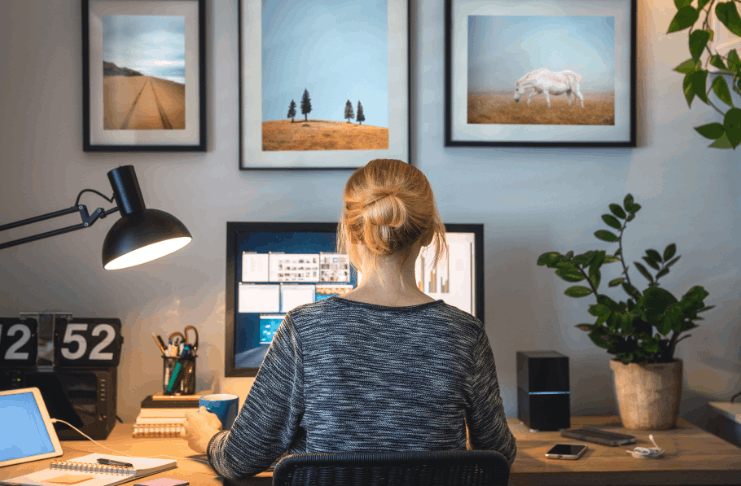If you’re seeking designer jobs, you might be wondering where to begin your search. Fortunately, with the rise of online job platforms, finding designer jobs has always been challenging. Whether you specialize in graphic design, web design, or UX/UI design, numerous resources are available to help you find your next career move.
In this article, we’ll explore some of the best online platforms for finding designer jobs and offer practical tips to help you stand out from the competition and secure your dream job.
Why Search for Designer Jobs Online?
Searching for designer jobs online can offer several benefits, including:
- Access to a wide range of job opportunities: online job platforms can connect you to opportunities from all over the world, giving you access to more job postings than you might find through traditional methods.
- Ease of application: many online job platforms allow you to apply for jobs with just a few clicks, making it easy to quickly submit your resume and portfolio to multiple employers.
- Greater control over your job search: with online job platforms, you can customize your search to fit your specific needs and preferences, such as location, salary, or job type.
- The ability to work remotely: online job platforms often have job postings that allow for remote work, which can be a huge benefit for designers looking for flexibility and work-life balance.
- Opportunities for freelance work: many online job platforms offer freelancers options, allowing you to build your portfolio and gain valuable experience in various industries.
Overall, searching for designer jobs online can be a convenient and effective way to find your next career move and can open up a world of possibilities that may not be available through more traditional job search methods.
The Top Online Job Platforms for Designers
There are many online job platforms available that offer job opportunities tailored explicitly to designers. Here are some of the top online job platforms for designers:
- Behance: is a leading platform for showcasing and discovering creative work and also features job postings for designers in various industries.
- Dribbble: is a popular community and job board for designers, with opportunities for freelance work and full-time positions.
- Upwork: is a freelancing site that connects businesses with freelance professionals, including designers of all specialties.
- 99designs: is a website that connects freelance designers with clients who need design work, including branding, web design, and other graphic design projects.
- Creative Hotlist: is a recruitment platform and career resource for creative professionals, including designers, writers, and marketers.
- Authentic Jobs: is a job board that connects creative professionals with job opportunities at design-focused companies.
- SimplyHired: is a job portal that aggregates job postings from multiple sources, including design-specific job boards.
- Coroflot: is a job board and portfolio site for creative professionals, including designers in graphic design, industrial design, and UX design.
Overall, these online job platforms can offer a great starting point for designers looking for new job opportunities, whether you’re a freelancer or seeking a full-time position. Be sure to research and evaluate each platform to determine which ones align with your career goals and preferences.
Navigating Freelance Websites to Find Design Work
Freelance websites can be a valuable resource for designers seeking new work opportunities. Here are some tips for navigating freelance websites to find design work:
- Research the platform: take the time to evaluate the freelance websites available to determine which ones align with your needs and preferences. Some popular freelance websites include Upwork, Freelancer, and Fiverr.
- Create a strong profile: a strong profile is critical to attracting clients and winning projects on freelance websites. Show your skills and experience, and include a portfolio of your best work.
- Set competitive rates: pricing is an essential consideration for clients on freelance websites, so be sure to set competitive rates and reflect your experience and skills.
- Be proactive in your search: don’t wait for clients to come to you – be proactive in your search for work by browsing job postings and submitting proposals for projects that interest you.
- Communicate clearly and professionally: good communication is essential for success on freelance websites. Be sure to respond to client messages promptly and communicate clearly and professionally throughout the project.
- Build a strong reputation: building a solid reputation on freelance websites can help you attract more clients and win more significant projects. Be sure to deliver high-quality work, meet deadlines, and maintain a positive attitude throughout the project.
Overall, freelance websites can be a valuable tool for designers looking to find new work opportunities and build their portfolios. By following these tips, you can confidently navigate freelance websites and find success as a freelance designer.
The Benefits of Building Your Online Presence
In today’s digital age, having a solid online presence is becoming increasingly important, not just for social purposes but also for professional reasons. For designers, building an online presence can be a valuable tool for finding work, creating a professional reputation, and connecting with other professionals in the industry.
Here are some benefits of building your online presence:
- Greater visibility: by building an online presence, you can increase your visibility and reach a wider audience, potentially leading to new job opportunities and professional connections.
- Showcase your skills and work: an online presence allows you to showcase your skills, experience, and portfolio to potential clients and employers, making it easier to market yourself and your work.
- Build a professional reputation: a solid online presence can help you establish yourself as an expert in your field and build a positive reputation among clients and peers.
- Connect with other professionals: an online presence can facilitate connections with other professionals in the industry, allowing you to share ideas, collaborate on projects, and build a network of support.
- Increase credibility: having a professional online presence can increase your credibility and help you stand out from the competition, giving you an edge in the job market.
Overall, building an online presence can be valuable for designers looking to advance their careers and find new opportunities. Whether you create a personal website, showcase your work on social media, or participate in online communities, there are many ways to build a solid online presence and reap the benefits of a more connected, visible, and successful career.
Creating a Stand-Out Design Portfolio
A strong design portfolio is essential for showcasing your skills and experience to potential clients and employers. Whether you’re a graphic designer, web designer, or UX/UI designer, a well-crafted portfolio can help you stand out from the competition and secure new job opportunities. Here are some tips for creating a stand-out design portfolio:
- Start with your best work: your portfolio should showcase your best and most relevant result, so start by selecting your most vital pieces.
- Tailor your portfolio to your audience: depending on the job or client you’re targeting, you may need to customize your portfolio to highlight specific skills or experiences relevant to the job.
- Include a variety of work: your portfolio should showcase a range of your skills and experience, so include examples of different types of design work, such as branding, web design, and print design.
- Make it visually appealing: a strong design portfolio should be visually appealing and showcase your design skills. Use high-quality images, clean layouts, and typography that’s easy to read.
- Tell a story: use your portfolio to tell a story about your design experience, showcasing the progression of your skills and experiences over time.
- Make it accessible: your portfolio should be easy to access and navigate. Consider creating a website or using a portfolio platform to make it easy for potential clients to find and view your work.
- Keep it up-to-date: regularly update your portfolio with your latest and greatest work to ensure that it’s always relevant and showcases your most recent skills and experiences.
Creating a stand-out design portfolio is essential for building your professional reputation and securing new job opportunities. By following these tips, you can create a portfolio that showcases your skills and experience in the best possible light and helps you stand out from the crowd.
Networking for Designers: Using Social Media to Make Connections
Social media has become an increasingly valuable tool for networking and professional connections, especially in the design industry. Social media allows designers to connect with other professionals, showcase their work, and build their professional brands.
Here are some tips for using social media to network as a designer:
- Choose the right platforms: many social media platforms are available, but not all are suitable for professional networking. Platforms like LinkedIn and Behance are specifically designed for professional connections and are popular among designers.
- Optimize your profile: this should showcase your professional skills and experience. Use a professional profile picture, craft a compelling headline, and include a summary of your knowledge and skills.
- Engage with other professionals: is a two-way street, so be sure to engage with other professionals in the industry by commenting on their posts, sharing their content, and joining relevant groups or discussions.
- Share your work: is an excellent platform for showcasing your work and attracting potential clients and employers. Share your latest projects, and use relevant hashtags to help your work get discovered.
- Build your brand: can help you build a solid personal brand that showcases your skills and expertise. Share your thoughts and opinions on industry-related topics, and engage with other professionals to build a reputation as an expert in your field.
- Be authentic: it’s essential to be authentic on social media. Feel free to show your personality, share your interests, and connect with other professionals on a personal level.
Overall, social media can be a valuable tool for networking and professional connections in the design industry. Using these tips to optimize your social media presence, you can connect with other professionals, build your brand, and showcase your skills and expertise to potential clients and employers.
Popular Designing Jobs and Their Roles Explained
Freelance design jobs offer an excellent opportunity for creative individuals to work on diverse and exciting projects while maintaining flexibility and control over their schedules. From product design to web development, a wide range of design jobs can be pursued on a freelance basis.
Let’s explore sixteen popular freelance design jobs and briefly overview their roles and responsibilities.
- Graphic Designer – creates visual concepts and uses computer software or by hand, to communicate ideas that inspire, inform, and captivate consumers.
- UI/UX Designer – constructs and implements user-centered designs, researching user needs and translating user needs into intuitive and functional interfaces.
- Industrial Designer – develops appliances, electronics, toys, and automotive design.
- Fashion Designer – creates clothing and accessory designs, researches fashion trends, and works with manufacturers to create prototypes and final products.
- Architect – designs buildings and other structures, makes detailed plans, and manages construction projects.
- Interior Designer – builds functional and aesthetically pleasing indoor spaces, including designing layouts, selecting materials and furniture, and overseeing installations.
- Game Designer – designs video games’ rules, mechanics, and gameplay and creates visual and audio assets that enhance the gaming experience.
- Landscape Designer – constructs outdoor designs that are functional, beautiful, and sustainable, including designing parks, gardens, and public spaces.
- Freelance Product Designer – designs and develops product concepts and prototypes, collaborating with clients and manufacturers to ensure products meet their needs and specifications.
- Freelance Presentation Designer – produces compelling visual presentations, such as pitch decks, sales presentations, and conference materials, that effectively communicate ideas and data.
- Freelance Packaging Designer – develops and crafts packaging for various products, including creating 3D models and prototypes, choosing materials, and ensuring designs are functional and appealing.
- Web Designer – responsible for constructing and producing website visual layout and user interface, including selecting color schemes, fonts, and images, and ensuring websites are user-friendly and optimized for mobile devices.
- Freelance Logo Designer – designs logos and other visual branding elements that effectively represent a company or product and convey its personality and values.
- Design Consultant – provides expert design advice and guidance to businesses, helping them create practical and appealing visual branding and marketing materials and optimizing the user experience of their products or services.
- Freelance Digital Designer – conceptualizes and creates digital assets, including websites, email templates, social media graphics, and digital advertisements, that effectively communicate a brand’s message and engage customers.
- Freelance Website Developer – responsible for building and maintaining websites, creating layouts, choosing templates, and ensuring sites are functional and user-friendly. They may also handle website updates, security, and troubleshooting.
Tips for Nailing Your Designer Job Application
A robust designer job application can help you stand out from the competition and increase your chances of landing your dream job. Here are some tips for nailing your designer job application:
- Tailor your application to the job: every job is different, so it’s essential to tailor your application to the specific job you’re applying for. Research the company and the job requirements, and use this information to craft a personalized cover letter and resume.
- Highlight your relevant experience and skills: your cover letter and resume should highlight your relevant knowledge and skills that make you a good fit for the job. Be sure to mention any specific design software or tools you’re proficient in, and give examples of how you’ve used these skills in past projects.
- Showcase your portfolio: a strong portfolio is essential for a designer job application. Include a link to your portfolio or attach examples of your work demonstrating your skills and experience.
- Pay attention to details: attention to detail is essential for designers and is also crucial for your job application. Check for spelling and grammar errors, and make sure your application is visually appealing and easy to read.
- Follow up: after submitting your application, follow up with the company to express your continued interest and ask for updates on the hiring process.
- Be prepared for an interview: if you’re selected, be sure to prepare by researching the company and practicing your answers to common interview questions. Bring examples of your work and be ready to discuss your design process and problem-solving skills.
Overall, nailing your designer job application requires attention to detail, a strong portfolio, and a personalized approach that highlights your relevant experience and skills. Following these tips can increase your chances of standing out from the competition and landing your dream job.
Making the Most of Your Remote Design Career
Remote work has become increasingly common in the design industry, and many designers are taking advantage of its flexibility and freedom. However, remote work can also present unique challenges, such as staying motivated, communicating effectively, and managing time and distractions. Here are some tips for making the most of your remote design career:
- Establish a routine: set a schedule and routine for your workday to help you stay focused and productive. It can include specific work hours, breaks, and time for exercise or other activities.
- Create a dedicated workspace: create a dedicated workspace that’s free from distractions and has all the tools and resources you need to do your work effectively.
- Use collaboration tools: use collaboration tools like Slack, Asana, or Trello to communicate effectively with your team and stay organized.
- Communicate regularly: communication is vital when working remotely, so communicate periodically with your team and clients. Use video conferencing or phone calls to stay connected and build personal relationships with your colleagues.
- Take breaks: taking regular intervals to rest and recharge is essential, especially when working from home. Take a walk, meditate, or do another activity that helps you reset and refocus.
- Attend virtual events: attend virtual events like webinars or conferences to stay connected with the design community and continue learning and growing in your career.
- Seek feedback: it can be challenging to receive input when working remotely, so be proactive in seeking feedback from your team and clients to help you grow and improve your work.
Overall, making the most of your remote design career requires establishing a routine, creating a dedicated workspace, communicating effectively, taking breaks, attending virtual events, seeking feedback, and staying focused and productive. By following these tips, you can thrive as a remote designer and build a successful and fulfilling career.
Staying Up-to-Date on the Latest Design Trends and Skills
As a designer, staying up-to-date on the latest design trends and skills is essential to remain relevant and competitive in the industry. Here are some tips for staying current with the latest design trends and skills:
- Follow design blogs and websites: follow popular design blogs and websites, such as Behance, Dribbble, and Creative Blog, to stay up-to-date on the latest design trends and news.
- Attend design conferences and events: attend design conferences and events to network with other professionals and learn about the latest design trends and best practices.
- Take online courses and tutorials: take online courses and tutorials to learn new design skills and techniques. Platforms like Skillshare, Lynda, and Udemy offer various courses for designers at all skill levels.
- Join design communities: join online design communities, such as Slack groups or Facebook groups, to connect with other designers, share ideas, and collaborate on projects.
- Participate in design challenges: participate in design challenges, such as daily creative prompts or design competitions, to stretch your creative muscles and explore new design styles and techniques.
- Experiment with new tools and software: experiment with new design tools and software to stay current with the latest technology and workflows.
- Seek feedback and critique: seek input and review from other designers to help you improve your skills and stay current with best practices.
Overall, staying up-to-date on the latest design trends and skills requires a commitment to learning and exploring new ideas and techniques. By following these tips and staying curious and open-minded, you can continue to grow and develop as a designer and stay ahead of the curve in a rapidly evolving industry.
Balancing Job Search and Personal Projects: Finding Time to Pursue Your Passions
As a designer, balancing a job search with personal projects and passions can be challenging. However, finding time to pursue personal projects is essential for staying creative, building your portfolio, and exploring new ideas and techniques.
Here are some tips for balancing job search and personal projects:
- Set clear goals and priorities: set clear goals and priorities for your job search and personal projects, and create a schedule that allows you to balance both. Identify your most important tasks and allocate your time accordingly.
- Break projects into manageable tasks: break them into manageable tasks, and work on them in small increments. It will help you make progress without feeling overwhelmed.
- Use downtime: look for opportunities to work on personal projects during rest, such as during your commute or lunch break.
- Collaborate with others: collaborate with other designers or artists to share ideas and gain inspiration. It can also help you stay motivated and accountable.
- Take breaks: taking regular intervals to rest and recharge is essential. It can help you avoid burnout and stay focused and productive.
- Be patient: finding time to balance personal projects and job searches can take time. Be patient with yourself and trust the process.
- Prioritize self-care: prioritize self-care by getting enough sleep, eating well, and taking time for physical exercise or meditation. It can help you stay focused and productive and avoid burnout.
Balancing job searches and personal projects requires discipline, planning, and patience. By following these tips and making time for your projects, you can continue to grow and develop as a designer and pursue your passions while advancing your career.
Finding Your Next Move: Navigating Designer Jobs Online
Finding your next designer job online can be a highly effective and efficient way to advance your career and pursue new opportunities. By utilizing online job platforms, networking on social media, and creating a stand-out design portfolio and job application, you can showcase your skills and experience and stand out from the competition.
In addition, staying up-to-date on the latest design trends and skills and finding a balance between job search and personal projects are essential for building a successful and fulfilling career as a designer.
With the right tools and strategies, you can find your next career move online and continue to grow and thrive as a professional designer.











